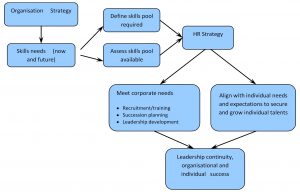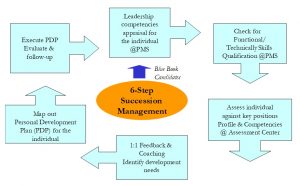Thinking ahead is a cardinal rule of business. In addition to monitoring the daily operations of your business, you need to think about the future. And, as difficult as it may be, it’s important to envision the day when you no longer will be in charge.
For successful organisations faced with demanding leadership requirements in a changing and competitive business environment, a succession planning process may be the most important human resource management investment the company can make.
The New Challenge
The defining characteristic of a successful organisation is increasingly recognised as human, rather than financial, geographical or production-based. This, together with the increased competition for management talent, is presenting human resources departments with new and challenging issues.
HR teams must attract, recruit and retain knowledge and skills, not just fill jobs with generic people. They need to track knowledge and competencies even more effectively and identify where gaps arise between current and future requirements. They have to work closely with business managers to understand how business strategy translates into the skills and knowledge needed. And they must have the confidence to retain both senior management and other employees.
A critical HR activity will be to develop a culture of continuous learning and growth for both individuals and the company as a whole. This is where a company-wide succession planning process will become an essential organisational asset. This process, which may or may not need to be supported by a computerised succession planning information system, can provide benefits that go beyond the traditional reason for succession planning, which has always been to assure the continuity of leadership at the top.
What is Succession Planning?
Succession planning is often described as “career planning at the top”, an extension of the principles and procedures that the company uses to merge the career aspirations of individual managers with organisational goals and management needs. Both career planning and succession planning are (or should be) “developmentally oriented”, that is focused on the long-term development of managers for future positions, as well as specific activities such as training, education and job-development.
However, because succession planning typically focuses on a few key leadership positions that are considered critical, and because these positions often have different requirements than other management jobs, succession planning usually requires a separate or additional set of “position requirements”. The skills and talents required to lead key function, business units or the organisation as a whole are not necessarily the same as those needed at intermediate or specialised management levels. For example, the job descriptions of data procession managers seldom call for a understanding of global economics or competitive marketing strategies.
Does Your Organisation Need Succession Planning?
Consider the following questions:
- Is turnover in key positions high?
- Are employees trained after they have been promoted?
- Do you consistently fill positions with external replacements?
- Does staff feel that advancement is based on personal or subjective criteria rather than them being best qualified?
If you answered yes to any of these questions, then you need to think seriously about implementing succession planning
Defining The Process
Effective succession planning and leadership development has to be based on clear understanding of the business strategy. This in turn determines the kind of people you need for effective leadership both now and in the future.
These requirements must then be mapped against information about individual employees. In addition to biographical detail, technical and professional skills, you should look at track core competencies – fundamental human skills and attitudes – and knowledge. This will be particularly powerful if you can also identify which competencies are required for current and future positions.
Figure 2 below illustrates the Succession Management Process developed for Aon Singapore and Asia.
The process distinctly illustrates three important components. Position Requirements are one of the three components that define a succession planning process and may require extensive data that is applicable only to key positions in the organisation. In the case of Aon, the key positions and position holders are recorded in a database, named RED book.
Like most organisations, Aon use competency models to assess employees (Figure 2) by using a set of criteria to identify internal candidates who match a position but may not have been nominated as a successor. Once candidates have been identified, information is recorded in the database, named BLUE Book. The potential successors will be assessed using the Competency Profiler tool to augment the competency with executive profiles, educational background, performance ratings, and other relevant information to assist in determining who to include in the succession pool.
“People Data” are the second component of succession planning. This step is usually more extensive than career planning because upper-level positions are more critical to business success and more should be known about managers who may ascend to these positions. For example, a career planning system might incorporate performance appraisal data that rates a manager’s performance on a scale of one to five. Data on potential company leaders should be more extensive and detailed, explaining the reasons for the rating and providing an overall context for the appraisal.
The third component in defining succession planning is Development Activities. They link people and their qualifications with the requirements of key positions. Developmental activities are also likely to include different, and sometimes unique, types of information and activities beyond those in a career planning process. For example, a career plan targeted at domestic marketing positions may not need to include education or experience with foreign governments or offshore production. However, a CEO candidate or Regional Marketing vice president would need this experience and/or knowledge.
Benefits of Succession Planning
An effective succession plan enables a company to identify and prepare the right people for the right positions at the right time and to identify, secure and grow a company’s knowledge base. In addition to building and securing company’s knowledge base, succession planning helps organisations to:
- engage senior management in a disciplined review of leadership talent
- ensure effective development plans are in place for key executives
- align management development, selection and reward with business requirements
- assure continuity of experience and leadership
- avoid premature or belated promotion
- retain and motivate management and key contributors
- ensure training budgets are spent effectively
Critical Success Factors
- The succession planning process must be supported by top management
- Line managers need to understand the benefits of succession planning
- Start small – focus on your most important people and positions first and establish a clearly defined process before addressing a wider population
- Take into account both the current and future strategic direction of management and organisational structures and culture
- Focus on development opportunities with the greatest impact for the business – cross-functional /cross sector assignments, mentoring, etc
- Aim to develop leadership team – not just functional skills in isolation
- Link organisational values and cultures to employee development
- Ensure the consistent data standards are used across the organisation whenever possible
- Choose a specialised succession planning software solution to manage the process.



